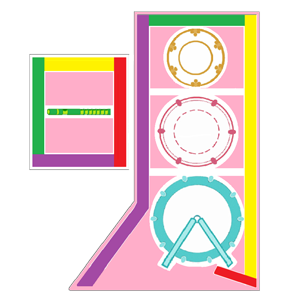Agency for Cultural Affairs Comprehensive Project for Children’s Development
Noh theater is a comprehensive art form that includes various elements such as drama, dance, music, literature, and art. This performance will focus on the music of Noh, the musical accompaniment, and introduce its unique musicality. The performance includes the fast-paced and light-hearted “Hayabue,” the slow and dignified “Oobeshi,” and the full-bodied “Shishi. The piece performed with the children is “Sanbanzo,” which repeats the same rhythm.
By appreciating and experiencing Noh music, we can feel “something invisible and inaudible to the eyes and ears,” and awaken senses other than the five senses that modern Japanese have forgotten, thereby nurturing children’s sensitivity.
◇Performance Program
This is a music (instrumental) only performance called “Hayashi-Do,” which focuses on the musicality of Noh theater.
- Opening remarks and introduction of the history of Noh … After straightening up and giving a proper greeting, the outline and history of Noh will be explained in an easy-to-understand manner.
- Early flute … This is the light, high-tempo music for the appearance of the dragon gods and demons.
- Explanations of each instrument and its appeal as Noh music.
Let’s try to express ourselves with the kake voice… You will experience the 4. - kake voice, a characteristic of Noh music. You will experience how it sounds and how the pauses change depending on how you use the kake voice.
- Oobeshi: The same melody and rhythmic pattern as the haya-fue, but the tempo is extremely slow, expressing a powerful, ultra-fast movement. The tempo is extremely slow and expresses powerful, ultra-fast movement. Students will learn how to express themselves in Noh music by comparing it to the haya-fue.
During the break, those who wish to can try out the kotsuzumi and otsuzumi drums. (Contact time) - Sanbanzo is a Kyogen dance piece that accompanies Onna. It is a very festive piece and the same rhythm is played repeatedly. This is a very festive piece and the same rhythm will be played repeatedly.
- Kagura is danced in front of the Iwato Gate in the mythical “Ama-no-Iwato-gakure,” which is said to be the beginning of the performing arts. It is said to be the beginning of the performing arts. It is a piece of music that can be said to be the origin of Japanese music, shaking the hearts of viewers (the DNA of the Japanese people).
- This is a dance piece for the lion, the spirit animal of Monju Bosatsu. This is the quintessence of Noh music, full of stillness, movement, interplay and spirit.
- Closing remarks and Q&A… Various questions will be answered. At the end of the performance, as at the beginning of the performance, the audience will make their presence known and greet the performers properly.
Performance time (about 95 minutes)

